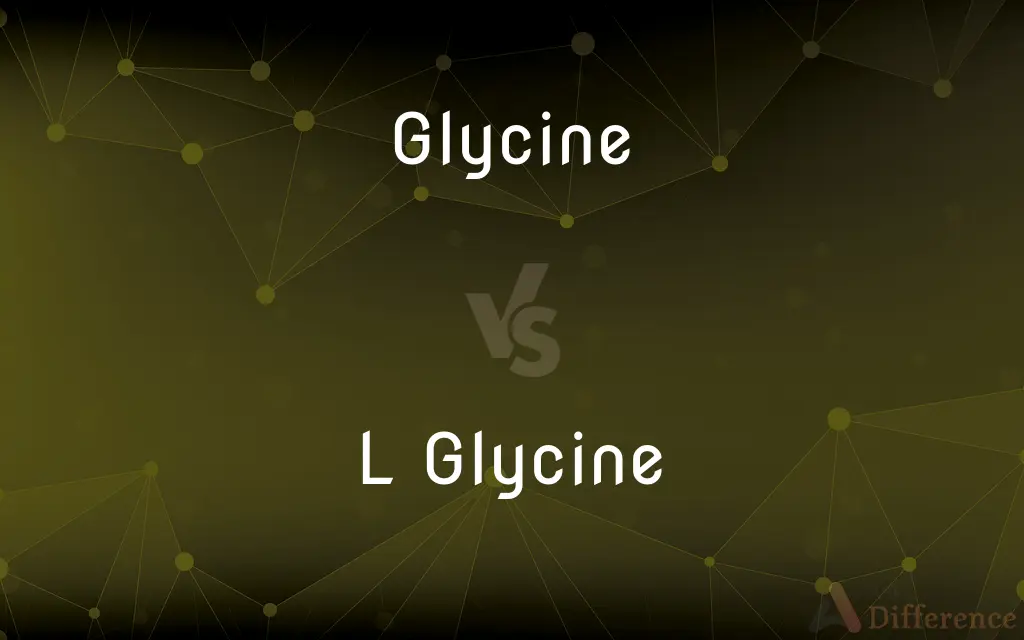Glycine vs. L Glycine — What's the Difference?
By Tayyaba Rehman — Published on November 13, 2023
Glycine is a simple amino acid, while L-Glycine refers specifically to the levorotatory isomer of glycine, denoting its spatial arrangement.

Difference Between Glycine and L Glycine
Table of Contents
ADVERTISEMENT
Key Differences
Glycine is one of the 20 amino acids that are used to build proteins in organisms. The term "Glycine" in the context of biochemistry and nutrition often refers to its simplest form, without specifying its stereochemistry. L-Glycine, on the other hand, specifies a particular isomer of the amino acid. Isomers are molecules with the same molecular formula but different physical structures.
When discussing Glycine, it's essential to recognize it as the simplest amino acid, having a single hydrogen atom as its side chain. L-Glycine, as a specifier, implies the orientation of the molecule, particularly the arrangement around the asymmetric carbon atom. All amino acids (except Glycine due to its simplicity) can exist in two different spatial arrangements (isomers), known as L and D forms.
Glycine is pivotal in the body's production of proteins, DNA, and phospholipids. While both Glycine and L-Glycine might serve similar biological functions, it is often unnecessary to specify the L-isomer in Glycine's case because it is not chiral. Hence, no D-isomer of Glycine exists naturally.
In the biochemical and nutritional context, Glycine is frequently used without the L specifier because it occurs primarily in the L-isomer form in proteins. Therefore, in nutritional supplements and biochemical contexts, “Glycine” often implies “L-Glycine”. However, to be structurally accurate, especially in scientific research or when discussing stereochemistry, using L-Glycine could add clarity.
Understanding Glycine usually encompasses its role in protein construction and metabolic functions. Even when talking about L-Glycine, these properties remain relevant, though the focus may shift slightly towards discussing the specific spatial arrangement of the molecule, even though this specification is often theoretically redundant in the case of Glycine.
ADVERTISEMENT
Comparison Chart
Stereochemistry
Non-chiral; no isomers
Specifies L-isomer
Terminology
Common in nutrition
Common in stereochemistry
Isomer Form
Not applicable
L-form (levorotatory)
Usage in Proteins
Predominantly found
Implicitly indicated
Scientific Naming
Often simply "Glycine"
Explicitly "L-Glycine"
Compare with Definitions
Glycine
Glycine is the smallest and simplest amino acid.
Glycine often acts as a biochemical intermediary in metabolic reactions.
L Glycine
L-Glycine is implied when discussing proteins’ structure.
Proteins contain L-Glycine, distinguishing the spatial orientation of its atoms.
Glycine
Glycine is non-chiral, with no D or L enantiomer.
Unlike other amino acids, Glycine does not have a D-form.
L Glycine
L-Glycine may be used to emphasize the stereochemistry in a scientific context.
To emphasize molecular orientation, a chemist might use the term L-Glycine.
Glycine
Glycine acts as a neurotransmitter in the central nervous system.
Glycine can inhibit or potentiate neurotransmission, depending on the receptor.
L Glycine
L-Glycine specifies the levorotatory isomer of Glycine.
L-Glycine denotes the spatial arrangement of atoms in the molecule.
Glycine
Glycine is used in the production of other amino acids.
Through transamination, Glycine can be converted into serine.
L Glycine
L-Glycine is unnecessary to specify due to Glycine's non-chirality.
Researchers rarely say L-Glycine since only one form is biologically relevant.
Glycine
Glycine is involved in the synthesis of purines, necessary for DNA production.
Glycine donates a carbon atom in the biosynthesis of the purine ring.
L Glycine
L-Glycine plays a role in metabolic and cellular functions.
L-Glycine, when metabolized, contributes to various physiological processes.
Glycine
A sweet-tasting crystalline nonessential amino acid, C2H5NO2, that is the principal amino acid occurring in sugarcane. The simplest amino acid found in protein, it is derived from the alkaline hydrolysis of gelatin and used in biochemical research and medicine.
Glycine
(amino acid) A nonessential amino acid, amino-acetic acid, C2H5NO2 found in most proteins but especially in sugar cane; the simplest amino acid.
Glycine
The simplest amino acid found in proteins and the principal amino acid in sugar cane
Glycine
Genus of Asiatic erect or sprawling herbs: soya bean
Common Curiosities
Is there a difference between Glycine and L-Glycine in biochemical function?
No, Glycine and L-Glycine refer to the same molecule functionally.
Does D-Glycine exist?
D-Glycine exists but is not naturally found in proteins.
What is Glycine?
Glycine is the simplest amino acid involved in protein synthesis and metabolic processes.
What is L-Glycine?
L-Glycine refers to the levorotatory isomer of Glycine, even though the "L" specifier is often unnecessary.
Why use "L" before Glycine?
The "L" specifies the spatial arrangement of Glycine, despite being somewhat redundant.
Are there side effects of Glycine supplementation?
Yes, excessive Glycine can cause gastrointestinal issues among other side effects.
What is the importance of Glycine in the central nervous system?
Glycine serves as a neurotransmitter, modulating neural activity.
Can Glycine exist in D and L forms like other amino acids?
It can, but naturally occurring Glycine in organisms is in the L-form.
Is specifying L-Glycine important in nutrition?
No, in nutrition, Glycine generally implies L-Glycine.
Is L-Glycine a necessary term in chemistry?
Rarely, because Glycine is not chiral, but it might be used for emphasis or clarity.
Why is L-Glycine commonly found in scientific research?
To ensure clarity and specificity regarding the isomer being discussed.
How does Glycine function in the body?
Glycine is involved in protein synthesis, neurotransmission, and metabolic pathways.
Does Glycine have different forms?
No, Glycine, being non-chiral, does not have multiple isomeric forms.
What role does L-Glycine play in metabolic pathways?
L-Glycine participates in pathways like purine synthesis and gluconeogenesis.
Share Your Discovery

Previous Comparison
Inborn vs. Natural
Next Comparison
Demand vs. Quantity DemandedAuthor Spotlight
Written by
Tayyaba RehmanTayyaba Rehman is a distinguished writer, currently serving as a primary contributor to askdifference.com. As a researcher in semantics and etymology, Tayyaba's passion for the complexity of languages and their distinctions has found a perfect home on the platform. Tayyaba delves into the intricacies of language, distinguishing between commonly confused words and phrases, thereby providing clarity for readers worldwide.














































